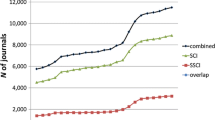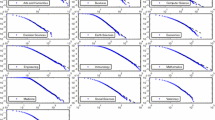Abstract
Can change in citation patterns among journals be used as an indicator of structural change in the organization of the sciences? Aggregated journal-journal citations for 1999 are compared with similar data in the Journal Citation Reports1998 of the Science Citation Index. In addition to indicating local change, probabilistic entropy measures enable us to analyze changes in distributions at different levels of aggregation. The results of various statistics are discussed and compared by elaborating the journal-journal mappings. The relevance of this indicator for science and technology policies is further specified
Similar content being viewed by others
References
Bar-Hillel, Y. (1955), An examination of information theory, Phil. Sci. 22: 86-105.
Burt, Ronald S. (1982), Toward a Structural Theory of Action. Academic Press, New York.
Doreian, P. (1986), A revised measure of standing of journals in stratified networks, Scientometrics, 11: 63-72.
Doreian, P., T. J. Fararo (1985), Structural equivalence in a journal network, Journal of the American Society of Information Science, 36: 28-37.
Frenken, K., L. Leydesdorff (2000), Scaling trajectories in civil aircraft (1913–1997), Research Policy, 29 (3): 331-348.
Fujigaki, Y. (1998), Filling the gap between discussions on science and scientists' everyday activities: applying the autopoiesis system theory to scientific knowledge, Social Science Information, 37: 5-22.
Garfield, E. (1990), How ISI selects journals for coverage: Quantitative and qualitative considerations, Current Contents (28 May): 5-13.
Kostoff, R. N., H. J. Eberthart, D. R. Toothman, R. Pellenberg (1997), Database tomography for technical intelligence: Comparative roadmaps of the research impact assessment literature and the Journal of the American Chemical Society, Scientometrics, 40 (1): 103-134.
Latour, B. (1987), Science in Action. Open University Press, Milton Keynes.
Leydesdorff, L. (1986), The development of frames of reference, Scientometrics, 9: 103-125.
Leydesdorff, L. (1987), Various methods for the mapping of science, Scientometrics, 11: 291-320.
Leydesdorff, L. (1994), Een Scientometrische Verekenning van de Biotechnologie. Rapport in opdracht van de Overlegcommissie Verkenningen (OCV), Amsterdam.
Leydesdorff, L.(1989), Words and co-words as indicators of intellectual organization, Research Policy, 18: 209-223.
Leydesdorff, L. (1995), The Challenge of Scientometrics: The development, measurement, and self-organization of scientific communications. DSWO Press/Leiden University, Leiden, at http://www.upublish.com/books/leydesdorff-sci.htm
Leydesdorff, L. (1998), Theories of citation?, Scientometrics, 43 (1): 5-25.
Leydesdorff, L. (2001), A Sociological Theory of Communication: The Self-Organization of the Knowledge-Based Society. Universal Publishers, Parkland, FL, at http://www.upublish.com/books/leydesdorff.htm
Leydesdorff, L., P. Van der Schaar (1987), The use of scientometric indicators for evaluating national research programmes, Science & Techology Studies, 5: 22-31.
Leydesdorff, L., S. E. Cozzens (1993), The delineation of specialties in terms of journals using the dynamic journal set of the Science Citation Index, Scientometrics, 26: 133-154.
Leydesdorff, L., S. Cozzens, P. Van den Besselaar (1994), Tracking areas of strategic importance using scientometric journal mappings, Research Policy, 23: 217-229.
Leydesdorff, L., É. Gauthier (1996), The evaluation of national performance in selected priority areas using scientometric methods, Research Policy, 25: 431-450.
Leydesdorff, L., P. Van den Besselaar (1997), Scientometrics and communication theory: Towards theoretically informed indicators, Scientometrics, 38: 155-174.
Luhmann, N. (1984), Soziale Systeme. Grundriß einer allgemeinen Theorie. Suhrkamp, Frankfurt a.M., (Social Systems, Stanford University Press, Stanford, CA, 1995).
Luhmann, N. (1990), Die Wissenschaft der Gesellschaft. Suhrkamp, Frankfurt a.M.
Martin, B., J. Irvine (1983), Assessing basic research: Some partial indicators of scientific progress in radio astronomy, Research Policy, 12: 61-90.
Merton, R. K. (1968), The Matthew effect in science, Science, 159 (5 January): 56-63.
Moed, H. F., W. J. M. Burger, J. G. Frankfort, A. F. J. Van Raan (1985), The use of bibliometric data for the measurement of university research performance, Research Policy, 14: 131-149.
Narin, F. (1976), Evaluative Bibliometrics. Computer Horizons, Inc., Cherry Hill, NJ.
Narin, F., E. Noma (1985), Is technology becoming science? Scientometrics, 7: 369-381.
Nederhof, A. J. (1988), Changes in publication patterns of biotechnologists: An evaluation of the impact of government stimulation programs in six industrial nations, Scientometrics, 14: 475-485.
Price, D. de Solla (1965), Networks of scientific papers, Science, 149: 510-515.
Rosenberg, N. (1982), How exogeneous is science? In: Inside the Black Box: Technology and Economics. Cambridge University Press, Cambridge, pp. 141-159.
Shannon, C. E. (1948), A Mathematical theory of communication, Bell System Technical Journal, 27: 379-423 and 623–656.
Simon, H. A. (1969), The Sciences of the Artificial. MIT Press, Cambridge, MA/ London.
Small, H. (1978), Cited documents as concept symbols, Social Studies of Science, 7: 113-122.
Studer, K. E., D. E. Chubin (1980), The Cancer Mission. Social Contexts of Biomedical Research. Sage, Beverly Hills.
Swanson, D. R. (1990), Medical literature as a potential source of new knowledge, Bull. Med. Libr. Assoc., 78: 29-37.
Theil, H. (1972), Statistical Decomposition Analysis. North-Holland: Amsterdam/ London.
Tijssen, R., J. de Leeuw, A. F. J. van Raan (1987), Quasi-correspondence analysis on square scientometric transaction matrices, Scientometrics, 11: 347-361.
Tijssen, R. J. W. (1992), Cartography of Science: scientometric mapping with multidimensional scaling methods. DSWO Press/ Leiden University, Leiden.
Van den Besselaar, P. (2000), Communication between science and technology studies journals, Scientometrics, 47: 169-193.
Van den Besselaar, P., L. Leydesdorff (1996), Mapping change in scientific specialties: A scientometric reconstruction of the development of artificial intelligence, Journal of the American Society for Information Science, 47: 415-436.
Van den Besselaar, P., G. Heimeriks (2001), Disciplinary, multidisciplinary, interdisciplinary: Concepts and indicators. Paper to be presented at the 8 th ISSI Conference for Scientometrics and Informetrics, Sydney, July.
Van den Daele, W., W. Krohn, P. Weingart (1979) (Eds), Geplante Forschung: Vergleichende Studien über den Einfluss politischer Programme auf die Wissenschaftsentwicklung. Suhrkamp, Frankfurt a.M.
VlachÝ, J. (1988), Informationsanalyse zur Supraleitungsforschung, Physikinformationen, 14: 15-49.
Whitley, R. D. (1984), The Intellectual and Social Organization of the Sciences. Oxford University Press, Oxford.
Wouters, P. (1999), The Citation Culture. Unpublished Ph.D. Thesis, University of Amsterdam.
Zsindely, S., A. Schubert, T. Braun (1982), Editorial gatekeeping patterns in international science journals: A new science indiator, Scientometrics, 4: 57-68.
Author information
Authors and Affiliations
Rights and permissions
About this article
Cite this article
Leydesdorff, L. Indicators of structural change in the dynamics of science: Entropy statistics of the SCI Journal Citation Reports . Scientometrics 53, 131–159 (2002). https://doi.org/10.1023/A:1014892106059
Issue Date:
DOI: https://doi.org/10.1023/A:1014892106059




